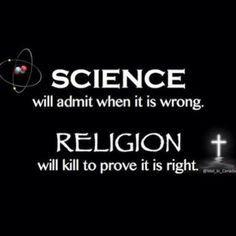
"The Danger Of Science Denial"
TED Talk by Michael Specter
Alan: Notice that "Science" corrected itself.
This is because The Scientific Method is self-correcting, continually trying to prove itself wrong.
It is a measure of human stupidity that most people pontificate self-righteously -- "See, I told you so!" -- whenever science proves itself wrong, when, in fact, it is precisely the ability to prove oneself wrong that demonstrates sufficient intelligence to distinguish oneself from "the idiots."
Would that this core element of Science be embedded in the bowels of every human psyche.

This is because The Scientific Method is self-correcting, continually trying to prove itself wrong.
It is a measure of human stupidity that most people pontificate self-righteously -- "See, I told you so!" -- whenever science proves itself wrong, when, in fact, it is precisely the ability to prove oneself wrong that demonstrates sufficient intelligence to distinguish oneself from "the idiots."
Would that this core element of Science be embedded in the bowels of every human psyche.

In his 1973 classic film, “Sleeper,” Woody Allen plays a cryogenically preserved Greenwich Village health food entrepreneur who is brought back to life in the year 2173.
Upon awakening, he requests a breakfast of wheat germ, organic honey and tiger’s milk — puzzling his futuristic medical handlers.
“Those are the charmed substances that some years ago were thought to contain life-preserving properties,” one physician explains.
“You mean there was no deep fat?” a second asks, horrified. “No steak, or cream pies — or hot fudge?”
“Those were thought to be unhealthy, precisely the opposite of what we now know to be true,” the first doctor responds.
He offers Allen’s character a cigarette, urging him to “be sure you get the smoke deep down into your lungs.”
Life imitates art: After 40 years of warning Americans to avoid cholesterol-rich foods, the nation’s top nutrition panel is poised to tell the public, in effect, “never mind.”
The Dietary Guidelines Advisory Committee, which shapes authoritative federal nutritional recommendations, has concluded that there is insufficient evidence to back up its long-standing 300-milligram-per-day limit on cholesterol intake, The Post reported last week.
Cholesterol in the blood remains a heart disease risk factor. It’s just that consuming the stuff in the form of, say, shrimp scampi or a large omelette doesn’t seem to raise those levels, as previously thought.
So much, perhaps, for the 20-year-old federal requirement that food makers label their products for cholesterol content, adding a non-trivial amount to the cost of packaging.
So much for untold gazillions’ worth of “no cholesterol” advertising aimed at health-conscious consumers. Between 2000 and 2014, the share of new food products boasting no, low, or reduced cholesterol nearly doubled, from 4.3 percent to 8.7 percent, according to AdAge.
Shed a tear for America’s egg industry, falsely accused of blocking the nation’s arteries. Per capita consumption of eggs, the yolks of which contain an average 186 milligrams of cholesterol, fell from 24 pounds in 1971 to 18 pounds in 1995, with only a modest recovery since then, according to the Agriculture Department.
There’s a lesson here for all of us, especially those who urge that this or that public policy be dictated by “the science.”
To be sure, that lesson is not that all science is as poor a guide to policy as the cholesterol research that led to such misallocation of scarce resources. Evolution, certainly, is established beyond a reasonable doubt, as is the link between tobacco and cancer, “Sleeper’s” joke notwithstanding.
Still, some science is bound to disappoint, or mislead, at significant social and financial cost, before it gets corrected. Unfortunately, consumers, or voters, including the best-educated ones, are poorly positioned to separate the wheat from the chaff.
Bronislaw Malinowski, the cultural anthropologist, famously explored overlaps among magic, science and religion, explaining that “[m]agic is to be expected and generally to be found whenever man comes to an unbridgeable gap, a hiatus in his knowledge, or in his powers of practical control, and yet has to continue in his pursuit.”
Written in 1931 regarding what was known, in the argot of the time, as “primitive man,” Malinowski’s words nevertheless describe the typical American. There’s a limit to how much science we can understand on our own; we take the rest on faith, either because we think it’s advantageous, or because we see no practical alternative, or because people often defer to authority.
Doctors and researchers, authors of “medical miracles,” are more like a priesthood, or a cadre of sorcerers, than we generally admit. Their legitimacy is based on something real, and time-tested — the scientific method — but it also comes from the mystique of their diplomas and white coats.
And, like priests, even scientists can be led into error — whether through good faith, self-interest or simple “scientific inertia,” a synonym for conventional wisdom, which was the culprit in the cholesterol case, according to a researcher cited by The Post.
We’re doomed to rely on science; imperfect as it is, it beats the alternatives. The trick is for scientists to produce their work with appropriate humility, and for citizens to consume it with appropriate skepticism. For all the money, time and energy we wasted on mistaken beliefs about cholesterol over the past few decades, at least the error got corrected through continued research, well before 2173.
Precisely because it is, or aspires to be, value-free, science is better at describing social problems than solving them. Policymaking is all about value judgments and trade-offs. Science can prove that man-made climate change, for example, is real; the “right” way to address it is a matter of morality and politics.
And in a democracy, a PhD’s vote counts the same as that of a Greenwich Village shopkeeper.
Read more from Charles Lane’s archive, follow him on Twitter orsubscribe to his updates on Facebook.
No comments:
Post a Comment